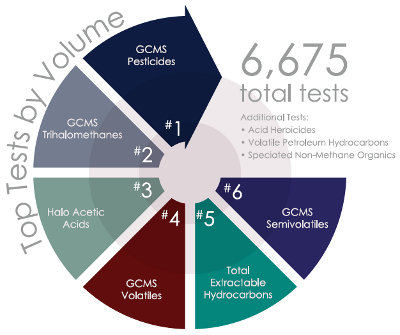GC Analysis
The Gas Chromatography team performs chemical analysis on samples to identify and measure potentially toxic organic compounds. (A gas chromatograph is a piece of laboratory equipment that performs analysis by separating the compounds without chemically decomposing them.) The gas chromatograph pinpoints the presence of contaminants in soil, water and air in very small (parts-per-billion) concentrations.
The unit also performs drinking water testing for numerous public water supplies in the state, ambient air testing, and a number of special projects for University Departments, the Iowa Department of Natural Resources and private clients.
Matt
Mainprize, environmental chemist, works in the Volatiles laboratory.

FY13 achievements:
- The implementation of a new laboratory information management system, OpenELIS, had a profound effect on activities in the GC Analysis area. OpenELIS helped facilitate many efficiencies, including elimination of Sample Preparation Logbooks, management of trip blanks as quality controls rather than as samples, preparation of sample orders that can include analyte selection, and automation of maximum contaminant level (MCL) violation notices for drinking water.
- Restoration of ambient water monitoring by the Iowa Geological Survey (IGS) significantly increased testing levels for several pesticide groups included in this project, particularly for GCMS Pesticides determined by U.S. Environmental Protection Agency Method 8270. Other new testing for the IGS included projects for monitoring pesticides in wetlands (farmed and river) and groundwater.
- The GC Analysis group validated and implemented testing to support the EPA Unregulated Contaminant Monitoring Regulation 3 (UCMR3) methods 524.3 and 522. The EPA utilizes the Unregulated Contaminant Monitoring program to collect data for contaminants suspected to be present in drinking water, but that do not have health-based standards set under the Safe Drinking Water Act (SDWA). Samples collected for the UCMR3 program must be submitted for testing to EPA-approved laboratories, such as the State Hygienic Laboratory.